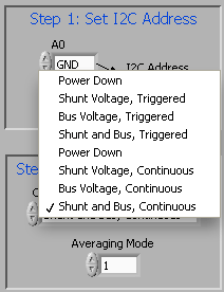SBOU124B march 2012 – july 2023 INA230
- 1
- INA230EVM Evaluation Board and Software Tutorial
- Trademarks
- 1Overview
- 2INA230EVM Hardware
- 3INA230EVM (Rev A) Hardware Setup
- 4INA230EVM Software Setup
- 5INA230EVM Software Overview
- 6INA230EVM Documentation
- 7Revision History
5.2.2 Configure Operating Mode
The second step of the INA230EVM configuration process allows the user to set the operating mode and the averaging mode.
The operating mode allows the user to restrict the amount of calculations done within the INA230 by changing the conversion to be triggered or continuous, or by shutting down the part altogether. When the device is operating in triggered mode, the device only performs conversions when the operating mode is set and the Write All Reg button at the top of the screen is selected. After the mode changes and Write All Reg is selected, the user must select the Read All Reg button to see the changes on the device reflected in the software.
When the INA230 is operating in continuous mode, conversions are performed directly after the previous conversion is complete. When the INA230EVM software is in continuous mode, the user can click the Read All Reg button to update the software at any time.
Power-down mode stops all conversions from taking place until the operating mode changes again. The device remains attached to power but draws minimal current and does not perform any conversions.
All three operating modes can also be limited to only measuring certain components of the device, as shown in Figure 5-4. Note that for complete functionality of the INA230, the user must choose a configuration with Shunt and Bus configuration. Failure to choose Shunt and Bus configuration disables a considerable portion of the unit functionality as discussed in the INA230 data sheet.
 Figure 5-4 Configuring Operating Mode
Figure 5-4 Configuring Operating ModeThe Configure Operation step also contains a drop-down box to select Averaging Mode. The user can set up the INA230 to take the average of several measurements before storing the value of the measurements in the register table.